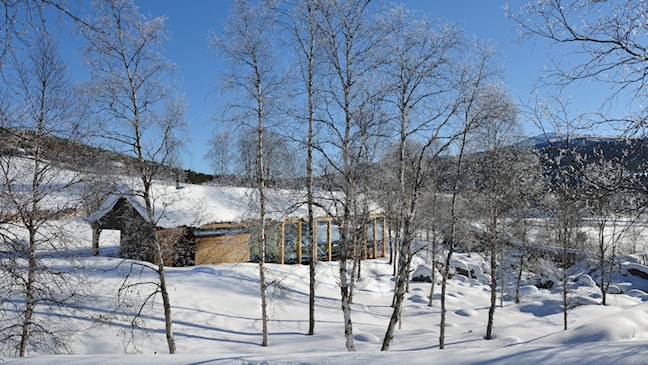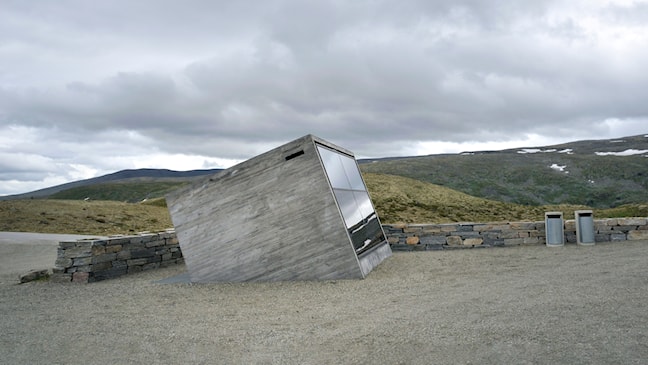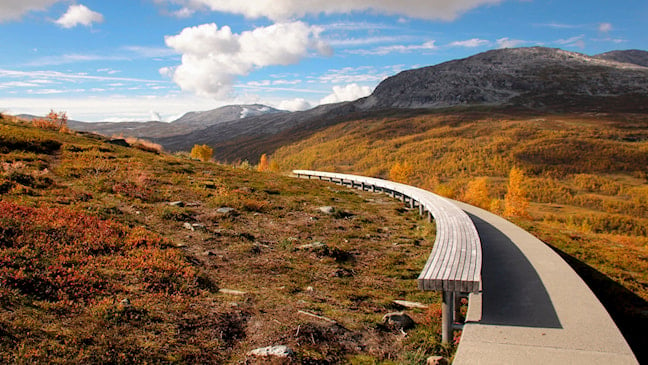LJB AS - Lars Berge
Atnbrufossen Vannbruksmuseum
The river house at Atnbrufossen in the Rondane mountains is a plain, light building which was not intended to draw too much attention to itself.
- Landscape architect:
- LJB AS - Lars Berge
- Finished:
- 2013

Efforts were therefore made to imbue the house with a local character, although with an independent identity that respects its environment. The river house is a modern wooden construction composed of solid-wood elements in a laminated wood frame, with a pinewood exterior and roof. Large glass panes cover the façade facing the river and the waterfall. The interaction between the light-coloured birch trunks and the horizontally elongated building evokes a particular atmosphere when you observe the waterfall from the exhibition room.
Flotane
Here, you enter a new landscape with rolling hills and wide plains with peaks and glaciers in the distance.
- Landscape architect:
- LJB AS - Lars Berge
- Finished:
- 2010

After a seemingly never-ending ascent from the sea up the mountainside, it is only when you reach the plateau at Flotane on the Aurlandsfjellet mountain that you finally feel that you have “arrived”. Here, you enter a new landscape with rolling hills and wide plains with peaks and glaciers in the distance. At Flotane, the idea was to delimit the site, mark out its functions and provide for experiences. The rest area has been upgraded with benches and a service building powered by a solar panel. Flotane also provides ample parking for those who wish to hike along the old construction road leading into the mountains.
Vedahaugane
A walkway and an “infinity” bench curve elegantly away from the road, gently sloping upwards then back towards the valley. The walk guides you to a artwork
- Artist:
- Mark Dion
- Landscape architect:
- LJB AS - Lars Berge
- Finished:
- 2012

The road serpentines up the Erdalen valley, crosses the treeline and leads your gaze towards valleys and peaks. Before facing the severe high-altitude conditions waiting further up, and sitting snugly sheltered against the wind, you can enjoy the view of the landscape, the valley and the peaks of the Jotunheimen massif. A concrete gangway and an unending bench curve elegantly from the road, gently upwards and back down towards the valley. Hovering on columns, it makes no contact with the terrain, taking you to an intriguing artwork in the form of a den at its end. The bench invites you to take a break in the curve, enjoying your view of choice. The gangway is accessible for wheelchair users. It is narrow enough to be light and elegant, but sufficiently wide for a contemplative stroll.
The basis for the art project at Aurlandsfjellet is the untouched nature along the route.On the north side of Aurlandsfjellet, with a view towards Lærdal, is Vedahaugane and Mark Dion’s DEN (the winter lair), a bear’s winter lair, where we are invited into the underground cave. The work of art stands in strong contrast to the Stegastein viewpoint on the south side of the mountain with its spectacular view of the Aurland Fjord.
DEN is an artificial stalactite cave that houses a bear resting on a bed of items that have been found in second-hand stores in Norway and abroad. The pile of items represents the cultural history, with artefacts from the Viking Period at the bottom and items from our time at the top. A bluish light trickles from the opening in the roof. Mark Dion directs our attention to the nature surrounding us and to the power relationship between man and nature. Who will be victorious – nature, as represented by the bear, or the culture that has stolen the bear’s original environment and basis of existence?
The design of the entrance and the cave itself were created in collaboration with the Norwegian architect Lars Berge. DEN was opened in September 2012.
Mark Dion (1961) was selected as the artist for the project at Aurlandsfjellet. He is an American residing in New York. He has been involved in projects and exhibitions throughout the world. Dion is preoccupied with the environment and the threat modern life represents to all life in nature. He often uses elements from natural sciences as a basis for his art, such as zoology, botany and biology. Several of his installations resemble exhibits found in museums of natural sciences, where nature and fauna are presented in a factual manner. He often does the same thing, but with a personal twist. When Dion’s works are presented in art galleries and art museums, they are interpreted differently than they would be in a museum of natural history. He says that he often organises his works as a Martian would; “findings” are numbered and the elements are organised, but without the academic logic and information employed by the sciences.